Think of solar panels, and you’re likely picturing large installations on rooftops or open fields. But what if we bring it closer to home… like your balcony? Can you really install solar panels on a balcony?
The answer is yes! Solar panels can indeed be installed on a balcony. This solution could be particularly advantageous for those living in apartments or buildings without direct roof access.
In the world of solar energy, it has been understood that not everyone has access to a spacious rooftop or a large backyard.
This realization has sparked innovative solutions, one of them being the ability to install solar panels on a balcony.
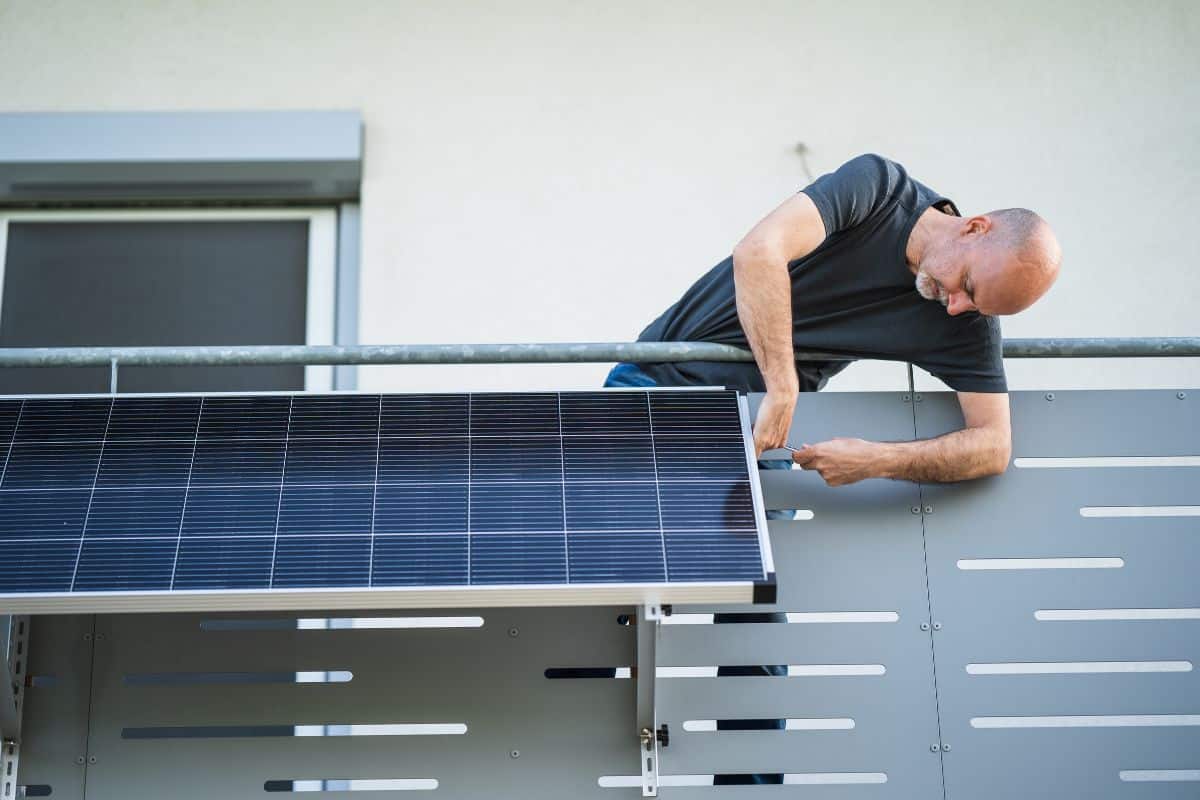
This is an exciting prospect, especially for apartment dwellers who have always wanted to tap into the potential of solar energy.
Before you jump into action, though, it’s essential to understand that this setup is slightly different from your standard rooftop installation. It comes with its own set of challenges and considerations.
Firstly, the orientation and size of your balcony are crucial factors.
Most solar panels perform best when facing south. This will allow them to receive full sun exposure, ideally with little to no shading during peak sunlight hours.
However, not all balconies face this optimal direction. Some may be significantly shaded by the building itself or other structures nearby.
How big must your balcony be for solar?
In terms of size, you need sufficient space to accommodate the solar panels. You also need to leave enough room for safety and maintenance access.
The larger the area you can dedicate to the solar installation, the more energy you can potentially generate.
Secondly, unlike roof installations, which can be firmly anchored, balcony installations need to be secure without causing damage or posing safety risks.
Wind is a crucial consideration, as panels must be mounted in a way that prevents them from being blown over.
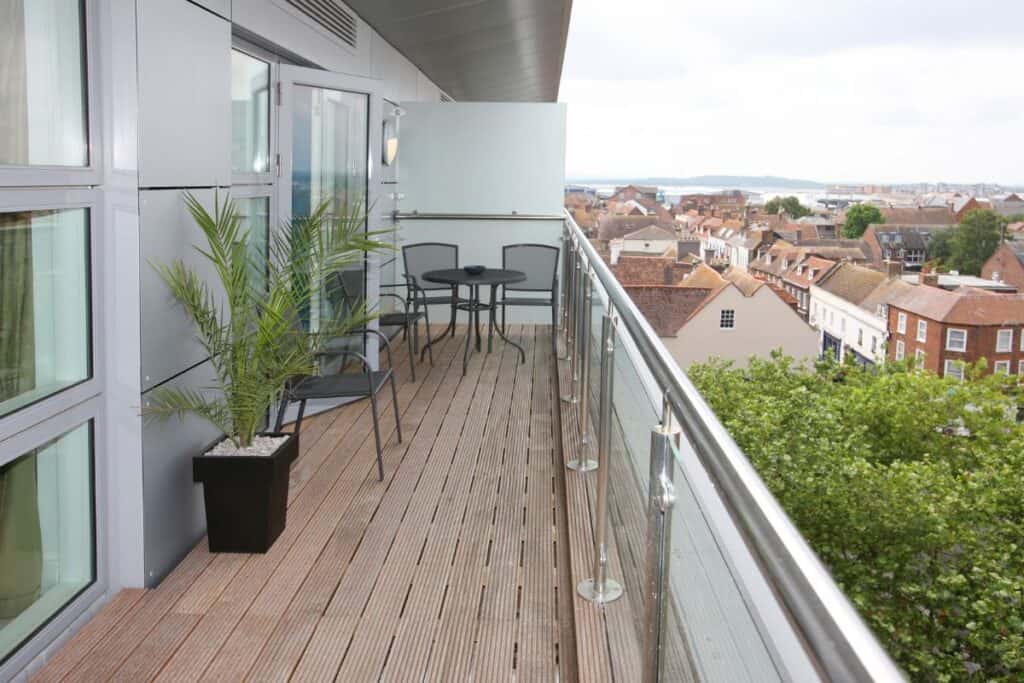
Another critical factor is the building’s regulations and the local laws.
Some housing associations or city codes may have rules that restrict the installation of solar panels on balconies or enforce specific safety requirements.
Always check with your building manager and local authorities before planning the installation.
Lastly, bear in mind that while balcony solar panels can contribute to your energy needs, they are unlikely to produce as much power as a full-scale rooftop installation due to space and orientation limitations.
But don’t let this dissuade you! Every bit of solar-generated power helps reduce your reliance on grid electricity and contributes to a more sustainable future.
So, the short answer is, yes, it’s possible to install solar panels on a balcony. But the practicality of doing so will depend on several factors.
With careful planning and consideration, though, you could be well on your way to harnessing the power of the sun right from your apartment balcony!
Let’s dig into each of those factors in more detail now…
Essential Factors for Installing Solar Panels on Your Balcony
Before embarking on a balcony solar installation, several key factors should be considered to ensure success.
This doesn’t mean that it’s an impossible feat. Understanding these factors will help you assess whether this solution fits your unique circumstances.
First and foremost, the direction your balcony faces is a crucial factor. Ideally, your solar panels should be south-facing in order to capture the most sunlight.
If your balcony faces east or west, your solar panels may still capture a good amount of sunlight, but not as much as they could if they were south-facing.
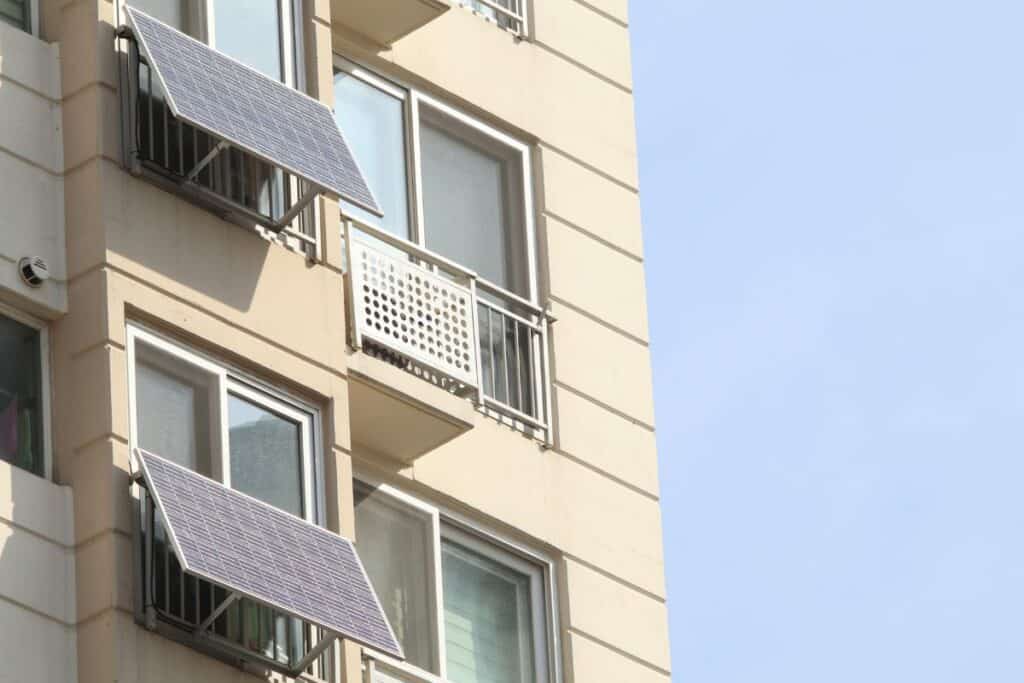
For north-facing balconies, the benefits may be significantly less due to reduced sun exposure.
Secondly, take into account the size of your balcony. The larger your balcony, the more solar panels you can accommodate, which means more energy production.
Measure your balcony carefully, bearing in mind that you need to leave room for safety and maintenance access.
Another aspect to consider is the shading on your balcony.
Don’t discount the effect of shade
You might face challenges if your balcony is significantly shaded by other parts of the building, nearby structures, or trees.
Solar panels require direct sunlight to operate at their best, and even partial shade can impact their efficiency.
The local climate is also a factor. If you live in an area with plenty of sunny days throughout the year, you’re more likely to benefit from installing solar panels on your balcony.
On the other hand, if your location experiences many cloudy or rainy days, your solar panels might not generate as much energy.
The rules and regulations of your building, as well as local laws, are also critical factors.
Some housing associations or city codes may have rules that restrict the installation of solar panels on balconies or enforce specific safety requirements.
Make sure to check these rules beforehand.
Lastly, consider the installation setup. Unlike rooftop solar panels that are firmly anchored, panels installed on balconies need to be securely mounted in a way that won’t cause damage or pose safety risks.
Remember, the panels will need to withstand varying weather conditions, especially strong winds.
So while installing solar panels on a balcony is possible, careful consideration of these factors will help determine whether it’s a viable option for you.
Consulting with a professional solar installer may also be beneficial. They can help assess your situation, provide valuable advice, and ensure that the installation is carried out safely and effectively.
Power Potential: How Much Energy Can Balcony Solar Panels Generate?
Understanding the power generation potential of balcony solar panels is essential for setting realistic expectations.
The amount of power produced can vary greatly, being influenced by several factors, including the direction the balcony faces, the amount of sunlight received, and the efficiency of the solar panels installed.
So how much energy can balcony solar panels generate?
To begin with, it is crucial to note that solar panels generally produce around 15 to 18 watts per square foot, depending on the panel’s efficiency. So, for a balcony of 10 square feet, you might generate between 150 to 180 watts in optimal conditions. This is under the assumption that your solar panels are directly under the sun without any shading or obstructions.
However, the direction your balcony faces significantly influences your solar panels’ performance.
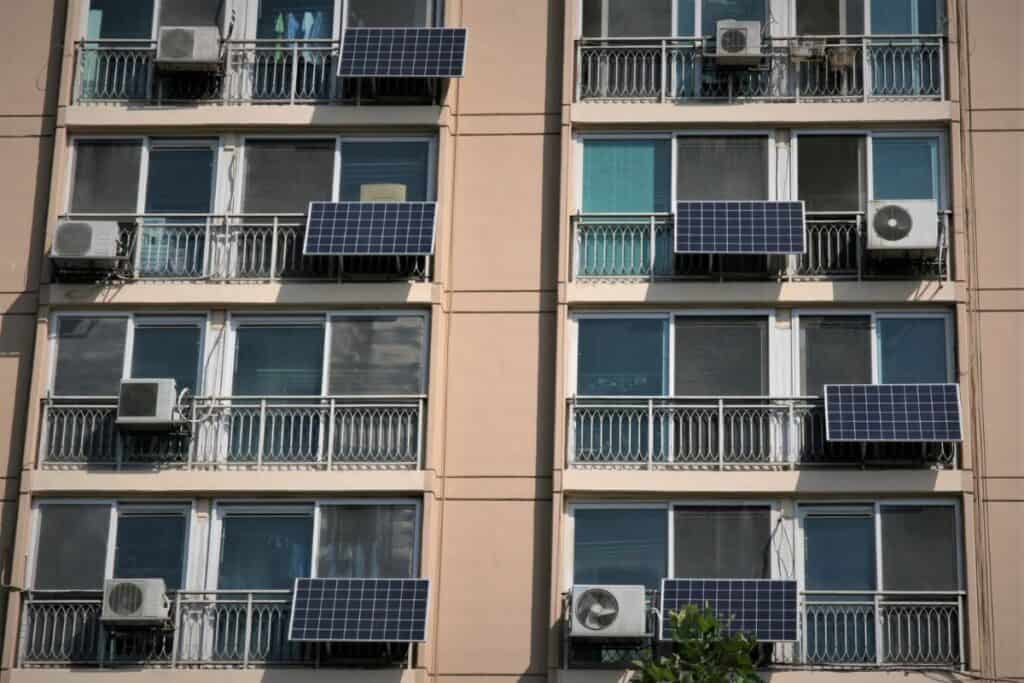
For instance, if you’re in the northern hemisphere and your balcony is south-facing, you’ll get the most sunlight throughout the day, resulting in maximum power output.
East or west-facing balconies can still harness a good amount of power but not as much as south-facing ones. North-facing balconies are the least ideal due to less sun exposure.
Another crucial aspect is the number of sun hours your location receives daily.
For instance, if you live in a place with an average of 5 peak sun hours per day, a 150-watt panel could theoretically produce 750 watt-hours (or 0.75 kilowatt-hours) of energy per day.
The impact of weather on balcony solar panels
However, keep in mind that weather conditions (like snow or hail), seasons, and shading can significantly impact the actual power production.
The efficiency of the solar panels installed is another key factor. Higher-efficiency panels will produce more power compared to lower-efficiency panels of the same size.
However, high-efficiency panels are usually more expensive, so you’ll need to consider the cost-effectiveness based on your energy needs.
Lastly, the orientation and tilt of the panels also matter.
Ideally, solar panels should be installed at an angle that matches your latitude to capture the most sunlight. However, this might not be possible on a balcony, so you may have to compromise.
While you can generate power with balcony solar panels, it’s important to manage expectations.
The actual power output can be influenced by many variables.
Consulting with a professional installer can provide a more accurate estimate tailored to your specific circumstances and help you make the most of your solar installation.
Regulations and Permissions: Installing Solar Panels on Your Balcony
It’s vital to understand the regulatory landscape and any permissions required beforehand.
The specifics can vary depending on your location, the type of building you live in, and its historical or environmental status.
In many areas, installing solar panels on a balcony doesn’t generally require planning permission. This is because it’s often considered a permitted development. However, certain conditions must be met. These include ensuring that the panels don’t protrude more than a specific distance beyond the balcony wall.
These rules can vary from place to place, so it’s essential to verify with your local planning authority.
If you live in a listed building or a conservation area, additional restrictions may apply.
In some cases, planning permission may be required, or the installation of solar panels might be disallowed entirely to maintain the historical or aesthetic character of the area.
For those living in apartment buildings or condominiums, it’s essential to check the building regulations and consult with your homeowner’s association (HOA) or building management.
Balcony space is often considered limited common property, meaning it’s assigned to a specific unit but is still part of the common areas. Therefore, any changes, including installing solar panels, usually need approval from the HOA or management board.
They will also ensure that the installation won’t compromise the structural integrity of the building or pose a hazard to other residents.
Does the local electrical code make a difference
In addition to building and planning permissions, you should also consider the local electrical code.
Solar panel installations must comply with specific electrical standards to ensure safety. A licensed electrician should always perform the wiring and connections to ensure they are done correctly and safely.
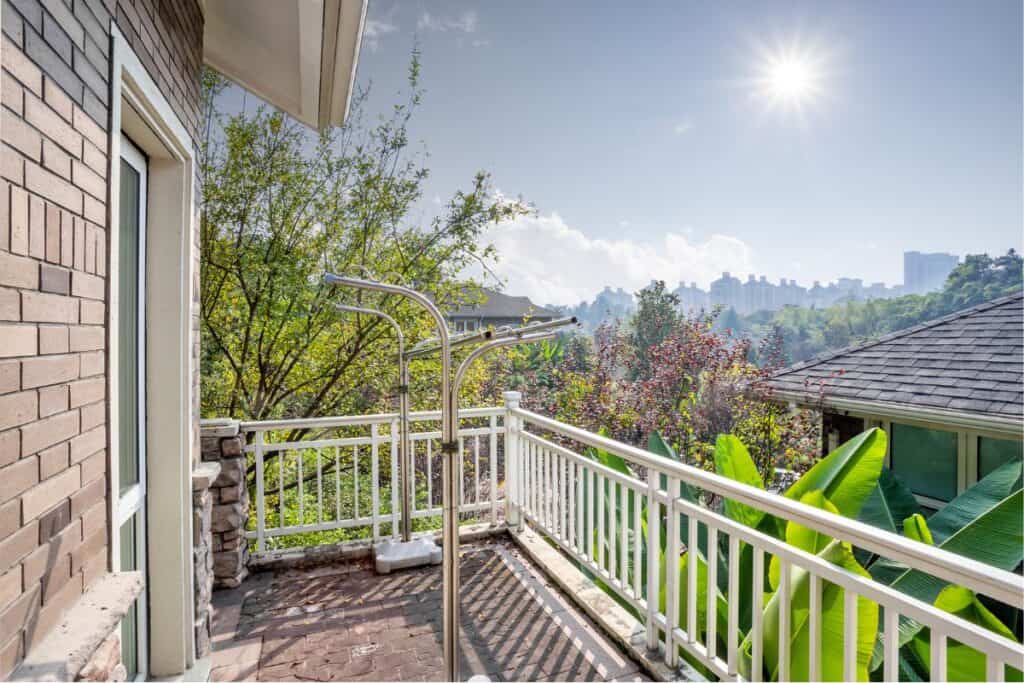
Lastly, consider any potential impact on your home insurance. Installing solar panels could affect your policy, and you may need to inform your insurance company of the changes.
Although there can be multiple regulatory and permission considerations, these should not deter you from pursuing your solar energy goals.
As a potential solar balcony panel owner, you need to do your due diligence and take the necessary steps to ensure your installation is compliant with all regulations, safe, and effective.
Consulting with solar professionals and local authorities can help guide you through the process, making your transition to green energy smoother and hassle-free.
The Impact of Balcony Orientation on Solar Panel Effectiveness
Understanding the orientation of your balcony can play a critical role in harnessing the maximum potential of your solar panels. The direction your balcony faces will influence the amount of direct sunlight your solar panels receive, thus affecting their overall power output.
The ideal orientation for balcony solar panels in the Northern Hemisphere is typically south-facing. This direction allows the panels to capture the most sunlight throughout the day as the sun moves from east to west. In the Southern Hemisphere, a north-facing orientation is preferred. If your balcony faces these directions, you’ll likely get the most energy output from your panels.
However, if your balcony faces east or west, you can still use solar panels, but there are a few things to consider.
East-facing panels will produce the most power in the morning when the sun rises, whereas west-facing panels will generate the most power in the afternoon and early evening.
Depending on when you use the most electricity, this might not be a disadvantage.
The science of solar
Furthermore, recent studies show that east-west oriented solar panels can still capture a significant amount of energy, albeit less than optimum south-facing panels.
A north-facing balcony in the Northern Hemisphere or a south-facing one in the Southern Hemisphere can be the most challenging for solar power generation.
These orientations will get less direct sunlight throughout the day, resulting in lower energy output.
However, even in these situations, solar panels can still generate power, particularly during the long summer days.
In addition to the cardinal direction, the tilt angle of your panels is also crucial. Solar panels perform best when they are perpendicular to the sun’s rays.
The optimal tilt angle can vary based on your latitude and the time of year.
In many cases, a flat placement (tilt angle of 0 degrees) might be the most feasible on a balcony, but even this can provide a reasonable output in a good location.
While the orientation of your balcony can significantly impact the effectiveness of your solar panels, it’s not the only factor to consider.
Even less-than-ideal situations can still generate a worthwhile amount of power. Therefore, don’t be discouraged if your balcony doesn’t face the “perfect” way.
Best Solar Panels for Balcony Installations
Selecting the right solar panels for a balcony installation is vital to maximize the energy production and overall efficiency of your system.
The best solar panels for your balcony will depend on a few key factors, including the available space, the orientation and shading of the balcony, and your budget.
In terms of size, smaller, more compact solar panels are usually ideal for balcony installations. Traditional rooftop solar panels may be too large and cumbersome for most balconies. Therefore, smaller solar panels designed for portable or flexible use can be an excellent option. These panels are lightweight, easy to install, and can fit into a variety of balcony layouts.
Thin-film solar panels, for example, offer a flexible and lightweight design that is suitable for confined spaces such as balconies.
They can be rolled out flat or curved around an object, offering a versatility that is particularly useful in small spaces.
However, it’s essential to note that thin-film panels usually have lower efficiency rates compared to other types, which means they produce less electricity per square foot.
Best efficiency balcony solar panels
If efficiency is a priority and space allows, monocrystalline solar panels are a great option.
They have the highest efficiency rates because they’re made from a single crystal structure.
This allows them to make better use of sunlight and produce more electricity than polycrystalline or thin-film panels. However, they’re also more expensive.
Another option worth considering is the solar panel kit designed for balconies, which comes with mounting hardware and cabling to make installation easier.
These kits often use smaller, more compact panels, perfect for a balcony setup, and can be a cost-effective and efficient way to start producing your own renewable energy.
Regardless of the type you choose, it’s essential to ensure that the panels are well-suited to your specific circumstances.
Consider factors like the amount of daily sunlight your balcony receives, any shading from surrounding buildings or trees, and how the panels will be mounted or positioned.
That all said, the “best” solar panels for a balcony installation will depend heavily on your individual circumstances and requirements.
Therefore, it’s important to evaluate your situation carefully, consider the pros and cons of different panel types, and consult with a solar installation professional to make the best choice for your needs.
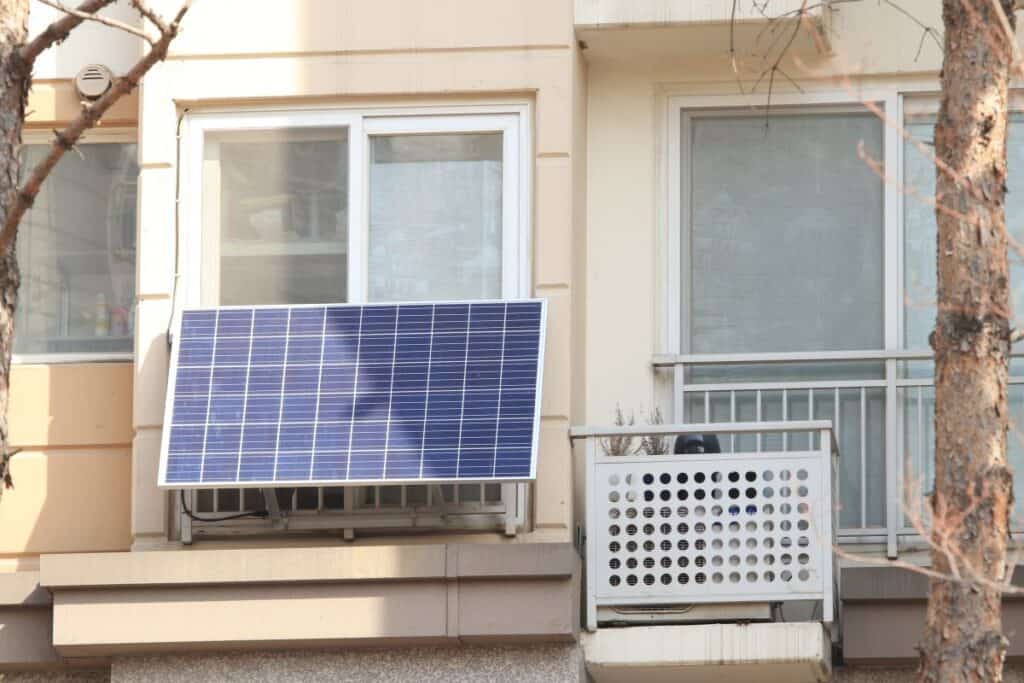
Maximizing the Efficiency of Solar Panels on Your Balcony
Getting the most out of your balcony solar panel installation relies on careful planning and regular maintenance. Below, we discuss some essential steps you can take to maximize the efficiency of solar panels installed on your balcony.
Firstly, consider the positioning and orientation of your solar panels.
Generally, solar panels perform best when facing south in the Northern Hemisphere and north in the Southern Hemisphere.
This is because they receive the most sunlight throughout the day in these positions. If this isn’t possible, east or west-facing installations can also work but may yield less power.
If your balcony is shaded by other buildings or trees, try to position your panels in the most sunlit area. Keep in mind that even partial shading can significantly reduce the efficiency of your solar panels.
Angle tilt of balcony solar
The tilt angle of your panels also plays a role in efficiency. Ideally, your panels should be tilted at an angle equal to your latitude to capture the most sunlight over the course of the year.
If your balcony doesn’t allow for this, aim for the best compromise between capturing sunlight and fitting the panels into the space.
The type of solar panels you choose can also impact efficiency. Monocrystalline panels are typically the most efficient but are also more expensive.
Polycrystalline panels are slightly less efficient but are also less costly. Thin-film panels can be a good choice for small or oddly shaped spaces but are less efficient than their crystalline counterparts.
Regular maintenance is another critical aspect of maximizing your solar panels’ efficiency.
Ensure that your panels are kept clean and free of dust or bird droppings, which can block sunlight and reduce their performance.
In addition, the use of a solar charge controller can help maximize efficiency.
These devices regulate the voltage and current coming from your solar panels, ensuring that your battery is charged correctly and not overcharged, which can decrease its lifespan.
Energy use habits can also affect how much you get out of your solar panels. Try to use power-hungry appliances during the day when your panels are generating the most electricity.
Lastly, regularly monitor your solar panel system’s performance. Monitoring systems allow you to track how much energy your panels are producing and identify any issues affecting their performance.
By paying careful attention to installation, maintenance, and usage, you can maximize the efficiency of your balcony solar panels and reap the most benefits from your renewable energy investment.
The Impact of Shading on Balcony Solar Performance
Shading, whether from buildings, trees, or other obstacles, significantly impacts the performance of solar panels installed on a balcony.
Below, we delve into how shading can affect your solar panels and ways to mitigate its impact.
Solar panels work by absorbing sunlight and converting it into electricity. When a portion of your solar panel is shaded, less sunlight hits the solar cells, thus reducing the amount of electricity generated.
It’s important to note that even a small amount of shade on one part of a solar panel can affect the entire system’s performance.
The effects of shading can be divided into two types: hard and soft shading.
The two types of solar shading
Hard shading occurs when an object completely blocks the sun, such as a building or a tree.
Soft shading refers to the shadow being diffused or spread out, like the shadow from a power line or a leafless tree.
Both types of shading reduce the output of your solar panels, but hard shading has a more significant impact.
The structure of solar panels also makes them particularly susceptible to the effects of shading.
Solar panels are typically composed of a series of connected cells. If even one of these cells is shaded, the output of the entire panel can be reduced.
This is because the shaded cell creates resistance, limiting the flow of electricity.
To mitigate the effects of shading, consider the layout of your solar panel system. Some solar panels can be installed with micro-inverters or power optimizers.
These devices allow each panel (or each section of a panel) to operate independently. If one panel is shaded, the rest of the system can still operate at full capacity.
Another solution is the strategic placement of your solar panels.
If possible, position your panels where they’ll receive the most direct sunlight throughout the day. Keep in mind that the sun’s position changes with the seasons, so consider this when choosing your panels’ location.
Monitoring your solar panel system’s performance can also help identify any issues caused by shading.
A sudden drop in energy output, especially at a time of day when your panels should be getting plenty of sunlight, could indicate a shading problem.
While shading can pose a challenge to the performance of balcony solar panels, it’s not insurmountable.
With careful planning, selection of appropriate technology, and regular monitoring, you can significantly reduce the impact of shading and optimize your solar panels’ performance.
Assessing Weight and Wind Resistance Safety of Balcony Solar Panels
Installing solar panels on a balcony involves careful consideration of weight and wind resistance to ensure safety. Let’s delve into these factors to understand what to consider when planning your solar installation.
When it comes to weight, balconies have load-bearing capacities that can’t be exceeded. Solar panels, while not excessively heavy, will add to the overall load on the balcony. A standard solar panel can weigh between 15 to 25 kg.
It is, therefore, crucial to consult with a structural engineer or a professional solar installer. This is to assess whether your balcony can bear the weight of the solar panels, their mounting hardware, and any additional equipment.
Another weight-related aspect to consider is weight distribution.
The weight distribution of balcony solar panels
If you have a larger balcony and plan to install multiple solar panels, ensuring that the weight is evenly distributed can help prevent structural issues.
Some solar panel installation companies provide solar panel racks or mounting systems designed specifically for balcony installations.
These systems are designed to distribute the weight evenly across the balcony surface, reducing the risk of overloading any specific area.
Wind resistance is another vital factor when installing solar panels on a balcony.
Solar panels, by their very nature, are large flat surfaces. This means they can catch the wind like a sail. This can cause them to be unstable or even damaged in strong winds.
This is particularly a concern for balconies in high-rise buildings. Wind speeds can be significantly higher than at ground level.
To counteract this, solar panels should be securely mounted to withstand high winds. There are specific mounting systems designed for this purpose.
Some systems even allow the angle of the solar panels to be adjusted, which can help to reduce the wind load on the panels.
Moreover, wind can also affect the performance of solar panels. Dust and debris carried by the wind can deposit on the solar panels, reducing their efficiency.
So, it’s essential to regularly clean the panels to ensure they continue to perform optimally.
While there are challenges to installing solar panels on a balcony, they can be effectively managed by careful planning and professional installation.
Remember, safety should always be your top priority. Always consult with professionals, and don’t compromise on the quality of the mounting systems and other equipment.
With these precautions, you can safely and effectively harness solar energy from your balcony.
Maintaining Balcony Solar: Key Requirements and Tips
Balcony solar panel maintenance is crucial for maximizing efficiency and longevity. So, how do you care for solar panels mounted on a balcony? Let’s delve into this topic to learn more.
The maintenance of solar panels installed on a balcony isn’t significantly different from those installed on roofs or in yards.
The primary maintenance task is to keep the solar panels clean. Dust, bird droppings, leaves, and other debris can accumulate on the surface of the solar panels. This educes their ability to capture sunlight and produce electricity.
While rain can help clean the panels to some extent, in drier regions or during periods of less rainfall, you might need to manually clean the panels.
A soft brush and warm, soapy water can usually do the job effectively. Be careful not to use any harsh or abrasive cleaning materials that could scratch or damage the panels.
Also, take note that balconies in high-rise buildings might be more exposed to airborne pollutants than ground-level installations. This can lead to more frequent cleaning requirements.
Checking the panels for wear and tear
Another part of maintenance involves inspecting the solar panels for any signs of damage or wear. Over time, the panels might develop cracks or other physical damage due to exposure to the elements.
Regular inspections can help identify such issues early. This allows you to address them before they significantly impact the performance of the solar panels.
Additionally, for installations that include a mounting system or other equipment, it’s essential to regularly check these components for any signs of wear or damage.
Loose bolts, corrosion, or other issues can compromise the safety and functionality of the solar installation.
For solar panels connected to a battery system, routine battery maintenance is also necessary.
This includes checking the battery’s charge levels and cleaning the battery terminals. This ensures the battery is operating at the correct temperature.
Some of these maintenance tasks can be done yourself. It is however advisable to have a professional solar panel maintenance service periodically check your system.
They can perform more thorough checks and identify potential issues that might not be obvious to the untrained eye.
So while balcony solar panels do require maintenance, the tasks are relatively straightforward and manageable. With regular cleaning and inspections, you can ensure your solar panels continue to produce clean energy efficiently, making the most out of your investment.
